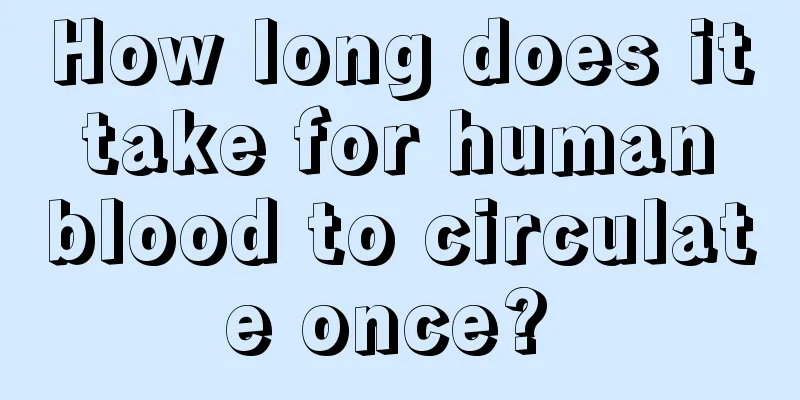How long does it take for human blood to circulate once?

|
Blood circulation is very important to the human body. As long as a person is alive, blood will circulate because the hemoglobin in the blood transports oxygen and expel carbon dioxide. Therefore, as long as the human body breathes, blood circulation will continue. Of course, if the human body is diseased, the blood circulation will be abnormal. How long does it take for normal human blood to circulate once? 1. Under chest compression, it takes about 3 minutes for blood to circulate throughout the body; it takes 0.5 to 1 minute for blood to circulate from the peripheral veins to the right atrium; it takes about 1 minute for blood to make a small circulation (the interval from the right atrium to the femoral artery) The energy generated by the human heart beats every day is enough to lift a 9 kg object by 1 meter. Therefore, the function of blood circulation is very powerful, and the human body is still very peculiar, so it is very necessary to have a proper understanding of blood circulation, which will help to increase awareness of disease. 2. Scientists calculate that the energy generated by a person's heartbeat from birth to the age of 50 can send 100 heavyweight artificial satellites into Earth orbit. The blood sent by the heart passes through the aorta, medium arteries, and arterioles, flows to the capillaries throughout the body, and then passes through the small veins, medium veins, and large veins, and returns to the heart. The blood travels in this order at a very fast speed, and it only takes 20 seconds to circulate once in the body. At this speed, the blood can circulate 180 times in an hour, and 1,576,800 times in a year. If a person lives to be 80 years old, the blood will circulate 126,144,000 times in the body. 3.1. Systemic circulation (macrocirculation): The blood vessels of the systemic circulation include the aorta and its branches that originate from the heart, as well as the superior vena cava, inferior vena cava, coronary sinus and its branches that return to the heart. The blood from the left ventricle is ejected into the aorta, along the arteries to the capillaries throughout the body, then merges into the small veins and large veins, and finally returns to the right atrium through the superior vena cava and inferior vena cava. The systemic venous circulation can be divided into three major systems: the superior vena cava system, the inferior vena cava system (including the portal vein system) and the cardiac venous system. The superior vena cava is a channel that collects venous blood from the head, neck, upper limbs, chest and back and returns it to the heart. The inferior vena cava system is a series of tubes that collect venous blood from the abdomen, pelvis, and lower limbs and return it to the heart. The cardiac venous system is the venous blood supply to the heart. Blood circulation is necessary for the human body because the blood in the body irrigates all organs. If any organ is lacking in blood, it will cause abnormalities. And if there is ischemia on the skin surface, the skin color will be different from other skin colors. If the skin is ischemic, it will appear cyanotic. |
<<: What are the foods that nourish the stomach and kidneys?
>>: What are the treatment options for esophageal fistula?
Recommend
Grape seed taking method and dosage
It has to be said that grape seeds are a health p...
How to provide postoperative care for colon cancer
Most cancer diseases require surgical treatment, ...
What are the hazards of fluorescent agents to the skin?
Nowadays, our children have more and more toys. M...
What is the best treatment for liver cancer? Comparison of liver cancer treatment methods
Liver cancer is a highly malignant tumor. It is m...
The difference between a goose and a gander
Goose is a common poultry animal in our daily lif...
What to do with closed trauma
Closed contusion mainly refers to a kind of injur...
Is prostate cancer hereditary?
Considering that there are more and more patients...
What causes lung cancer? What are the causes and clinical symptoms of lung cancer?
Lung cancer is a disease that everyone is familia...
What does milk spilling mean
Women who have had pregnancy experience should be...
Where is the location of hemorrhoids
Many people feel some discomfort in their anus, b...
Can an 82-year-old man with bile duct cancer undergo surgery?
Whether an 82-year-old man can undergo surgery fo...
Treatment of chronic arsenic poisoning
Patients with chronic arsenic poisoning must pay ...
Patients with laryngeal cancer should pay more attention to its common symptoms
In recent years, the incidence of laryngeal cance...
The harm of lymphoma should be taken seriously
Lymphoma patients suffer a lot. The pressure they...
Do you know about the benefits of chia seeds?
Losing weight is very important for both female a...









